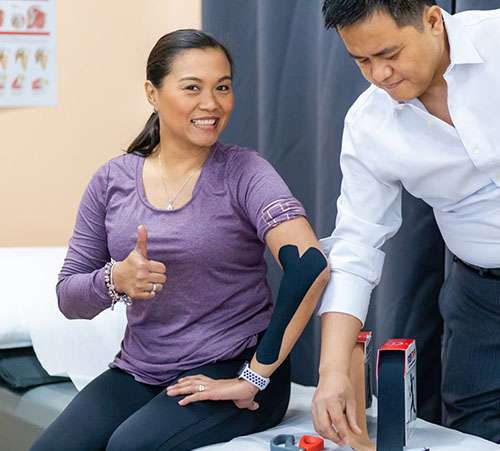Most Common Shoulder Conditions
-
Shoulder Bursitis
Shoulder bursitis is an inflamed bursa in the shoulder. The bursa contains fluid that reduces friction in your tissues. It also absorbs the forces of your muscles and tendons around the joint. Raising your arm many times such as painting, or sleeping on your side may hurt the bursa. This irritation can result in shoulder problems.
Signs & Symptoms
-
1. Shoulder pain & swelling
-
2. Disturb sleep
-
3. Worse when you sleep on the affected side
-
4. Pain increases when you raise the affected arm
-
5. Pain increases with activities
The Key to Recovery
-
1. Treat inflamed bursa
-
2. Medications
-
3. Don't sleep on the affected side
-
4. Avoid raising the arm overhead
-
5. Correct posture
Shoulder Impingement
Shoulder impingement means that soft tissues get trapped in the shoulder when raising the arm overhead. The repeated raising of the arm can pinch the tendons, bursa, or muscles around the joint. You’re at risk if you have rounded shoulder, muscle weakness, and bony spurs. The irritated tissues can worsen, and repeated the pinching can create tearing.
Signs & Symptoms
-
1. Shoulder pain and swelling
-
2. Increase symptoms when raising arm around 60 to 120 degrees
-
3. Disturb sleep
-
4. Difficulty repeated arm activities
-
5. Worse with overhead movements
The Key to Recovery
-
1. Treat the inflamed tissue
-
2. Temporary avoid raising the arm overhead
-
3. Strengthen weak muscles to prevent pinching
-
4. Improve posture
-
5. A gradual increase in exercise
Rotator Cuff Tear
The rotator cuff is composed of 4 muscles that hold the shoulder joint in place. It helps raise and rotate the shoulder joint. The usual cause of pain is the tendon if it is trapped and inflamed. The pain can lead to weakness and spasms of the muscles, which can get worse. If not given attention, it can lead to tearing.
Signs & Symptoms
-
1. Shoulder pain
-
2. Increase symptoms when raising the arm
-
3. Disturb sleep
-
4. Difficulty raising the arm overhead
-
5. Difficulty carrying and lifting
The Key to Recovery
-
1. Treat the rotator cuff tissue
-
2. Avoid activity that increases symptoms
-
3. Strengthen weak muscles
-
4. Improve posture
-
5. A gradual increase in exercise
Shoulder Tendinitis
Shoulder tendonitis is an inflammation of a tendon around the shoulder joint. It is caused by irritation from repeated overhead motion or an injury. Sleeping on your side can also hurt by the pressure on the tendon. The most commonly affected is the rotator cuff and the biceps tendon.
Signs & Symptoms
-
1. Pain & tenderness
-
2. Swelling
-
3. Muscle spasms
-
4. Increase symptoms when stretching tendons and muscles
-
5. Difficulty carrying, lifting, and overhead motion
The Key to Recovery
-
1. Treat inflamed tendon
-
2. Break adhesions
-
3. Avoid activity that increases symptoms
-
4. Correct muscle imbalance
-
5. Improve posture
Frozen Shoulder
Frozen shoulder is a condition affecting the capsule of the shoulder. This structure connects and encircles the joint. If you strain the capsule, it may get inflamed, then later shrink. It is also called adhesive capsulitis.
The main issue of frozen shoulder is severe stiffness. It begins with severe shoulder pain, then restricts shoulder motion.
Signs & Symptoms
-
1. Shoulder pain
-
2. Severe joint stiffness
-
3. Muscle weakness
-
4. Difficulty raising the affected arm
-
5. Difficulty self-care and daily activity
The Key to Recovery
-
1. Treat the inflamed capsule
-
2. Loosen shoulder tissues
-
3. Stretch the joint capsule
-
4. Strengthen weak muscles
-
5. Improve posture
The Right Care Approach For Your Situation
-
-
Protective
CareOur approach to care is to protect your injury or surgery. We focus on stopping more damage to your tissues and start the healing process.The ideal method of care when you can't function due to pain and weakness. You still depend on others fully to meet your needs.Our treatment is to protect, rest, ice, compress, and elevate the injured tissue with your prescribed medications. We will also teach you home remedies.Our goal is to kick-start your recovery and prevent secondary problems. We want you to heal at the expected time.
-
-
-
Gentle
CareOur approach to care is gradual when your condition is stable but painful. Then, we focus on faster healing of your tissues and recovery of function.The ideal method when your pain is bearable, but the movement is limited. Besides, you show difficulty performing self-care and daily routine.Our treatment is heat or cold, ultrasound, and TENS combined with massages. You will start with pain-free exercises to improve your functions.Our goal is to accomplish your daily needs with no assistance. We will prepare you to regain your primary activities.
-
-
-
Progressive
CareOur approach to care is aggressive when you need to regain normal function. Our focus is training related to your daily work and active life.The choice of care when performing your daily duties is still challenging. You still have an increase in pain with increasing activities.Our treatment includes manual therapy to deal with spasms and tightness. Then, we prescribe exercises and targeted work-outs to a balanced posture.Our goal is for you to perform daily duties and hobbies without pain. Moreover, we will guide you to improve your strength without difficulty.
-
-
-
Enhance
CareOur approach to care is to maximize your performance in sports. Therefore, we focus on specific training to boost your skills in a game.The perfect method when you need to optimize your skills. It will be best to refine your balance, agility, and posture to perform better in sports.Our treatment includes taping and manual therapy to activate muscle action. In addition, you practice targeted training for specific game skills.Our goal is for you to perform well in sports and enjoy your hobbies. Thus, we will help maximize your performance in your game.
-

Physical Therapy Method of Care
Our treatment is based on the proven method of physical therapy. We use techniques tested to help our patients recover and live pain-free.
For more than 20 years of experience, the methods and healing process is almost the same for each patient. But our approach depends on their issues. Besides, we treat patients as a human, not a body part.
Our best experience for recovery is to give proper care. We have to feel what our patients feel and understand their concerns. Only then we provide the best care.
At CT Physical Therapy Care, our happiness is to give you a 5 Start experience!

Contact Us
"*" indicates required fields
-


